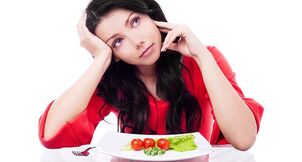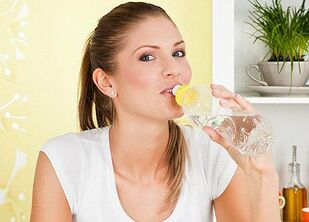Pancreatitis is one of the serious diseases of the digestive system. Distinguishing between acute and chronic pancreatitis, each of these types has its own characteristics and methods of treatment.

Pancreatitis is one of the serious diseases of the digestive system. Distinguishing between acute and chronic pancreatitis, each of these types has its own characteristics and methods of treatment.
But one thing has not changed in pancreatitis: the old way of life and diet will remain in the past, because the basis of the treatment of pancreatitis is a diet that is almost lifelong. The pancreas does not forgive eating disorders, immediately responds to pain and digestive disorders.
Basics of Pancreatitis
Pancreatitis is an acquired disease, it develops as a result of abdominal trauma, viral damage to the pancreas, due to liver and gallbladder disorders, after poisoning of alcohol and other toxic substances, with frequent and severe eating disorders - prolonged fasting, sitting on a diet to lowerbody weight.
The main signs of pancreatitis are:
- abdominal pain - sharp, dagger, almost to the point of loss of consciousness in acute pancreatitis, or dull or sore in the chronic version;
- nausea and vomiting;
- stool disorders, more severe diarrhea, fever;
- drastic weight loss.
Acute pancreatitis is usually hospitalized. Chronic exacerbations can be treated at home, but only under the supervision of a physician. Self-medication in case of pancreatitis is dangerous due to complications leading to necrosis of the pancreas (dilution of enzyme glandular tissue, self-digestion of the gland) and the development of peritonitis, which is fatal.
Nutritional therapy for pancreatitis
Medication therapy, enzymes and diet for pancreatitis are selected by the doctor, based on the patient's condition and test data. However, the general principles of diet correction are always almost the same. They give rest to the digestive and pancreas, which means they reduce pain and normalize well-being.
Nutrition in pancreatitis is very limited - most common products must be forgotten.You should eat regularly, about 5-6 times a day - every 2. 5-3 hours, with a break of 8 hours of sleep. But the portion according to volume must be small - about 200-250 g, especially for the first time after the onset of the disease.
All dishes are mechanically processed - they can all be used in cleaned form. Then, when the inflammation subsides, larger particles appear in the food, but you need to chew the food carefully.
Since the whole body is deficient in nutrients in pancreatitis,needs to increase the protein components in the diet (meat, fish, dairy products) - on average, up to 140-150 g of protein per day.
But fats and carbohydrates, which greatly strengthen the pancreas, are limited to a minimum. About 300 g of carbohydrates a day is given, fat - no more than 70-80 g.
Products that have a sokogonny effect - meat and fish broth, cabbage juice and broth - are removed from the diet; during a severe painful attack, therapeutic fasting is recommended for a period of 1-2 days under the supervision of a physician.
In case of pancreatitis, it is necessary to drink more fluids -it is recommended to drink up to 2 liters of clean water daily, about every half hour to take 2-3 sips of water throughout the day.

Naturally, with pancreatitis, you must quit smoking and alcohol consumption completely. They are the most powerful seizure provocateurs.
What should be excluded?
The list of forbidden foods will be very impressive and at first can be disappointing. However, without complying with these restrictions, a release can be expected for a very long time. Gradually, you will be able to increase your diet carefully, adhering to the general principles of good nutrition.
Therefore, for the entire acute period or the moment of deterioration of the chronic process, it should be excluded:
- beet soup, cabbage and borscht soup, okroshka, meat-based soup, mushroom and fish gravy, the gravy itself;
- fatty meats - pork, lamb, goose and duck;
- underwear - kidneys, heart, brain, liver;
- fried, smoked, salty and spicy foods;
- canned food;
- sausage;
- fatty fish (catfish, stellate fish, goldfish); caviar;
- lard, margarine, mayonnaise;
- fatty dairy dishes - cream, sour cream, koumiss;
- egg yolks, boiled eggs;
- millet, corn, barley, legumes;
- cabbage, radish, radish, radish, rutabagas, eggplant, onions and garlic, sorrel, cucumber, tomato and paprika;
- citrus, apples (sour type), grapes, pomegranates, cranberries;
- brown, preserved;
- spicy fries, sauce, marinade, vinegar, tomato sauce;
- all carbonated drinks, even mineral water (you can only use gas);
- strong tea and coffee, juice, cocoa;
- all fresh baked goods and pastries, pancakes, pies, short bread biscuits.
As you can see, the list of restrictions is quite large, but this is only for the duration of the acute process. Then gradually you can develop a diet gradually, but annoying and "heavy" dishes must be forgotten almost forever.
What can you eat?
This is the first question that arises after reading the list of prohibitions. Of course, his diet is not very varied, but aims to maintain the peace of the pancreas and reduce inflammation.

Allowed:
- dry bread yesterday, crouton;
- vegetable, my soup;
- steamed and poultry dishes - pieces of meat, meatballs, bread, pate, ginger;
- boiled fish fillets (lean), grilled fish, omelets;
- milk, cottage cheese, low-fat and light cheese, kefir;
- vegetable oil and butter (in porridge);
- vegetable puree and stew, boiled vegetables;
- pasta, noodles, from cereals - oatmeal, semolina, buckwheat, rice;
- sugar-free fruits (pears, apples, peaches, plums);
- compote, jelly, jelly;
- rosehip decoctions, herbal teas, bran drinks.
Of course, the diet is limited, but after consulting a doctor, you will gradually expand your menu.
Example Menu
Keep in mind that this menu can be used at home, when exacerbations subside, in the acute stage of pancreatitis, fasting and gradual introduction of food. When making a diet, remember: eat at least five meals a day, which is about the same as your calorie content and digestive load.
Menu for pancreatitis for 5 days
First Day
- Breakfast: mashed potatoes - 100-150 g, 2 croutons of white bread, 200 ml of mineral water (without gas! ).
- Second breakfast: steamed pieces of meat - 100 g, omelet - 100 g, white dry bread - 1 piece, 200 ml of milk (kefir).
- Lunch: vegetable soup - 200 ml, boiled fish - 100 g, zucchini puree - 100 g, white bread - 1 piece, rosehip broth - 200 ml, a third of bananas.
- Afternoon snacks: fruit jelly - 100 g, fat-free cottage cheese -100 g, mineral water - 200 ml.
- Dinner: oatmeal -200 g, pumpkin puree - 100 g, meatballs - 2 seeds. , weak tea with milk, a piece of dark bread.
Day Two
- Breakfast: buckwheat porridge -200 g, 2 croutons of white bread, 200 ml of tea with milk.
- Second breakfast: steamed beef cuts - 100 g, carrots - 200 g, dried white bread - 1 piece, 200 ml of dried fruit compote.
- Lunch: noodle soup - 200 ml, boiled chicken - 100 g, vegetables - 100 g, white bread - 1 piece, mineral water - 200 ml, half roasted pears.
- Lunch: apple sauce - 200 g, mineral water - 200 ml, Maria biscuits - 100 g.
- Dinner: mashed potatoes -200 g, low-fat cottage cheese - 100 g, sandwiches with cheese (30 g cheese, a slice of toast), weak tea with milk, a slice of dark bread.
Day Three
- Breakfast: pumpkin and pumpkin - 100-150 g, 2 croutons of white bread, 200 ml of mineral water (without gas! ).
- Second breakfast: low-fat cottage cheese - 100 g, half-baked pears, white dry bread - 1 piece, 200 ml of compote.
- Lunch: broccoli soup - 200 ml, boiled meat, grind in mashed potatoes - 100 g, mashed potatoes - 100 g, white bread - 1 piece, chamomile tea - 200 ml.
- Afternoon snacks: vegetable stew - 200 g, cheese - 50 g, mineral water - 200 ml.
- Dinner: buckwheat porridge -200 g, kefir - 200 g, half a banana, a slice of white bread.
Day Four
- Breakfast: mashed potatoes - 100-150 g, 2 croutons of white bread, 200 ml of mineral water (without gas! ).
- Second breakfast: rice porridge - 200 g, dry white bread - 1 piece, 200 ml of milk (kefir).
- Lunch: vegetable soup - 200 ml, boiled fish - 100 g, carrots - 100 g, white bread - 1 piece, rosehip broth - 200 ml, a third of bananas.
- Afternoon snack: omelet - 100 g, baked sweet apples, mineral water - 200 ml.
- Dinner: oatmeal -200 g, pumpkin puree - 100 g, meatballs - 2 seeds. , weak tea with milk, a piece of dark bread.
Day Five
- Breakfast: oatmeal -200 g, pumpkin puree - 100 g, steamed meatballs - 2 seeds. , weak tea with milk, a slice of dark bread
- Second breakfast: steamed pieces of meat - 100 g, omelet - 100 g, white dry bread - 1 piece, 200 ml of milk (kefir).
- Lunch: pasta soup - 200 ml, steamed fish pieces - 100 g, pumpkin ginger with carrots - 100 g, white bread - 1 piece, rosehip broth - 200 ml, Maria cake - 2 pieces.
- Afternoon snacks: toast - 100 g, fat-free cottage cheese -100 g, mineral water - 200 ml.
- Dinner: mashed potatoes - 100-150 g, 2 white bread crackers, 200 ml of mineral water (still! ).
By following your doctor's advice, following your diet, and following all prescriptions, relief can be achieved quickly. But a fairly strict diet with “heavy” food restrictions will last from 3 to 6 months. And you should always limit fatty, fried, spicy and canned foods.




















